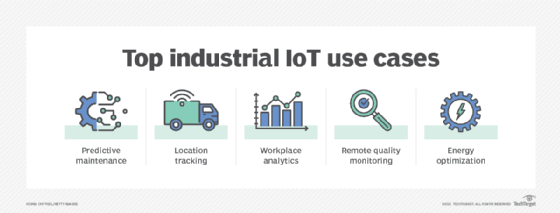
Top 5 industrial IoT use cases
As more organizations embrace IIoT, the technology will lead to more innovation and further improvements in use cases such as predictive maintenance and workplace analytics.
Organizations that look to capitalize on the latest technologies have adopted industrial IoT quickly, leading to the technology's rapid growth.
Even though IIoT is still relatively new and carries some challenges, the technology can bring competitive advantages to those who implement it successfully. The top industrial IoT use cases highlight just how valuable these technologies can be.
IIoT applies wireless technologies to industrial settings. Most often, IIoT means adding remote sensors to robotics or long-haul trucks, but organizations can also use the technology for a broad range of uses. The data-driven fourth industrial revolution, Industry 4.0, relies on IIoT to handle a broader variety of data collection and communication.
The global IIoT market was worth $76.7 billion in 2021, and experts predict it will surpass $100 billion by 2026, according to a Markets and Markets report. While the manufacturing sector isn't the only area to take advantage of these technologies, it drives much of this growth. More than 66% of manufacturers said the IIoT is crucial to their success, according to a 2020 survey by professional association Society of Manufacturing Engineers and Plataine, an AI-based IIoT software provider.
IIoT advantages and challenges
Industrial IoT use cases expand connectivity and improve visibility. With more real-time insight into their operations, organizations can make more informed optimization decisions. These connections also improve efficiency by establishing remote access. Machines with IIoT sensors can communicate with one another, making automated systems more flexible. Just as wireless real-time data improves human response time, it can let machines recognize and adapt to changing conditions. IIoT devices can also reduce energy consumption by adapting to use only what they need.
Despite its advantages, IIoT brings challenges. Most notably, more network endpoints can increase an organization's attack surface and vulnerability. An organization's reliance on endpoint devices makes attacks more destructive. Other potential issues include high upfront costs and initial disruption from the implementation of new technologies and changing workflows.
As IIoT adoption grows, these technologies will become more accessible and affordable, and advantages can offset initial expenses. More stringent cybersecurity standards can tackle growing cyberthreats, such as information security standard ISO 27001, which provides a framework for mitigating data breaches.

How organizations use IIoT
With these advantages and challenges in mind, here are five leading industrial IoT use cases that organizations gain from today:
1. Predictive maintenance
Predictive maintenance is one of the most popular use cases for the IIoT. Organizations use wireless IIoT sensor data to predict and alert workers when a machine will need maintenance. This IIoT use case prevents costly breakdowns and unnecessary repairs and improves machine uptime.
Implementing predictive maintenance has saved some organizations as much as $25 million by decreasing downtime. Any organization that relies on expensive machinery -- such as manufacturers, trucking companies or construction firms -- can see substantial savings from this use of IIoT.
For predictive maintenance to deliver these benefits, the analytics must have enough data. Finding and installing the necessary IoT equipment to gather information accurately can take time and come with high upfront costs. Because of these challenges, smaller facilities may have difficulty implementing predictive maintenance.
2. Location tracking
Location tracking with GPS systems, RFID tags, and other wireless technologies can show organizations where their assets are at any time. This transparency promotes increased efficiency.
Logistics companies often use location services to track shipments and reroute drivers when obstacles arise. Warehouses and manufacturing centers can also use location-based IIoT technologies to show workers where materials are. Real-time precise location data eliminates confusion, and employees can find what they need faster.
One of the most significant barriers facing location tracking systems is network coverage. Facilities need consistent, reliable connections to support real-time data across multiple assets, which organizations may not have. Upgrading to more reliable, higher-bandwidth networks with wireless technologies such as 5G can improve connectivity, but will bring extra costs.
3. Workplace analytics
With more IIoT devices in place, organizations will have access to more workflow data. Data scientists can feed the data into analytics engines that look for inefficiencies and suggest ways to optimize operations. Location data analysis can also highlight inefficiencies in warehouse organization.
Similar to predictive maintenance, these IIoT applications require large pools of reliable data to be effective. Facilities will need to implement vast IoT networks and gather data over long periods before these analytics offer useful and accurate insights. They will eventually provide a positive ROI, but that will take time to achieve.
4. Remote quality monitoring
Organizations like the Environmental Protection Agency use IoT sensors to monitor the quality of resources and products, such as water quality. Sensors provide faster and more cost-effective information about pollutants, which leads to quicker, more effective responses. Industrial organizations that rely on quality monitoring processes can apply IIoT to the same effect.
Chemical processing plants or pharmaceutical companies can use IoT sensors to monitor material or product quality remotely. Remote monitoring improves productivity when workers can check several processes in rapid succession. Similarly, real-time alerts prompt faster responses, mitigating accidents that could jeopardize the product if unchecked for too long.
Because remote quality monitoring is a relatively new concept, off-the-shelf products and services don't exist for every use case. Organizations may have to develop proprietary IoT technologies to measure metrics relevant to them, which can be expensive and challenging.
5. Energy optimization
A perhaps less glamorous but equally valuable industrial IoT use case is energy optimization. Bringing IoT connectivity to industrial machines, HVAC systems or anything that uses a lot of power can reduce energy consumption. IoT sensors can detect peaks and valleys in energy use and automatically adjust operations to use as little electricity as possible.
Considering how the industrial sector accounts for 33% of total energy consumption in the U.S., the potential for energy savings is considerable. Manufacturing may be the most common target for these IIoT-based improvements, but any company that uses electricity can take advantage of savings.
IIoT use has proved the technology effective in reducing energy consumption, but these savings are often marginal. Without mechanical upgrades, power optimization can only go so far in reducing related expenses. If organizations want to achieve substantial energy savings, they must implement additional technologies on top of IoT sensors.






